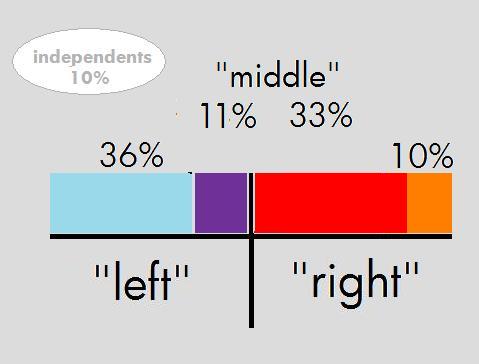A lot of Americans are quick to grab at the totem of “moderate,” but what does this really mean?
Here’s a graphic I made and posted a while back on the old site, but unfortunately I’ve since lost the demographics I was using to derive it:
 We have four colors represented in the graph:
We have four colors represented in the graph:
- Light Blue: Progressive democrats, primarily concerned with economic fairness and human rights.
- Dark Purple: Centrist or Nationalist/Corporatist Democrats. Despite making up a smaller part of the voting population, they are the majority of elected representatives.
- Red: Nationalist or Mainstream Republicans, primarily concerned with military dominance, appeasing corporate overlords in hope of bring trickled down upon, and religion.
- Orange: Liberal Republicans, Libertarians, Ron Paul Republicans, and other populist organizations
Independents can be anywhere really, a lot of the times they will address each issue on its own merits rather than sticking to any particular political labeling. This subgroup might pick a leader based on single issues, or even personality, character, or debate performance.
Now, what happens is that progressive Democrats continue to support moderate candidates, and these candidates actually share more in common with the Neo-cons of Bush’s administration than they do with the progressives who are supporting them. In a corporatist political environment, competing sectors seek political favors to expand their market power, and the centrist realm is dominated by the dominant beneficiaries of government policy. Basically, the military, the media, unionized manufacturing, and public employee unions share a pro-nationalist expansionary policy at all times, because they are the primary beneficiaries of any such spending.
Since 2008:
Following Obama’s election, we began to witness one of the most significant electoral shifts in the last several generations. Not only have the progressives begun to put pressure and spoken out against the Democratic majority in Congress, but a lot of Republicans have also begun to drift away from their traditional party leadership.
One factor promoting this shift is the new nature of online media. Dissatisfaction with old experts has created a niche for bloggers and amateur pundits who want to spread their political ideas. Since the reach of new media is so much more focused than old mass-media, the newer splinter groups may share some ideas without necessarily being unified into a new political front.
Electoral Outlook:
The policies defined by the moderate middle (corporate subsidy and militarist nationalism) will increasingly face attack from the left and right flanks.
As the Republican party continues to factionalize, progressive leaders will seize on the opportunity to collect disaffected libertarians and populist conservatives. A new opposition party will spring up to the left of today’s “centrist Democrats,” and the old Republican Reagan coalition will fade into irrelevancy.
Well, that’s the optimistic case… 😉